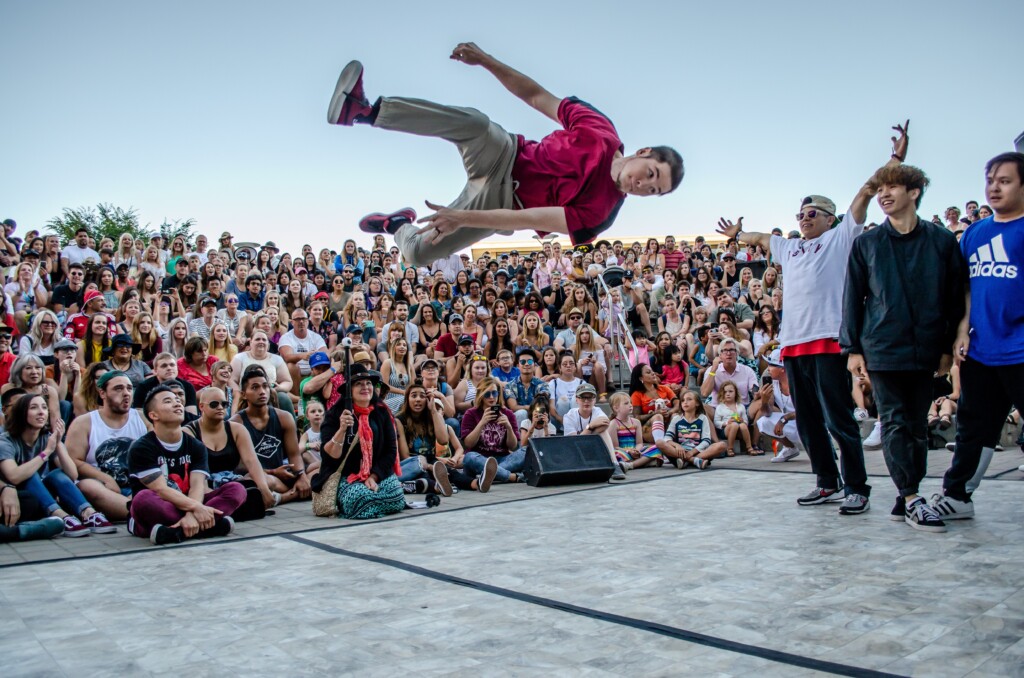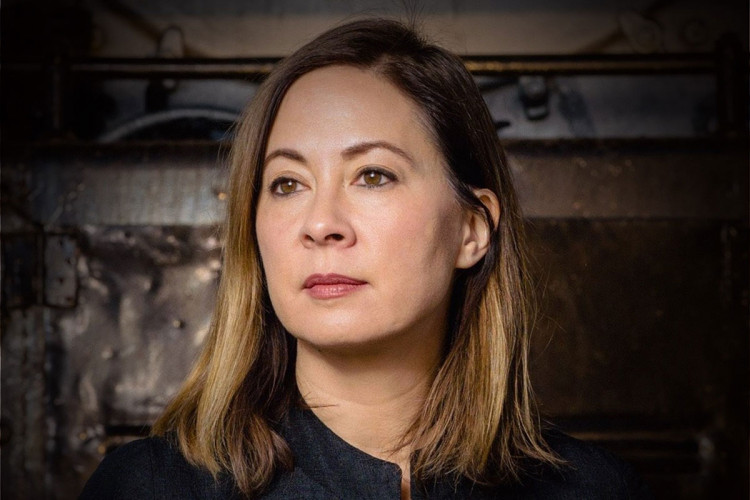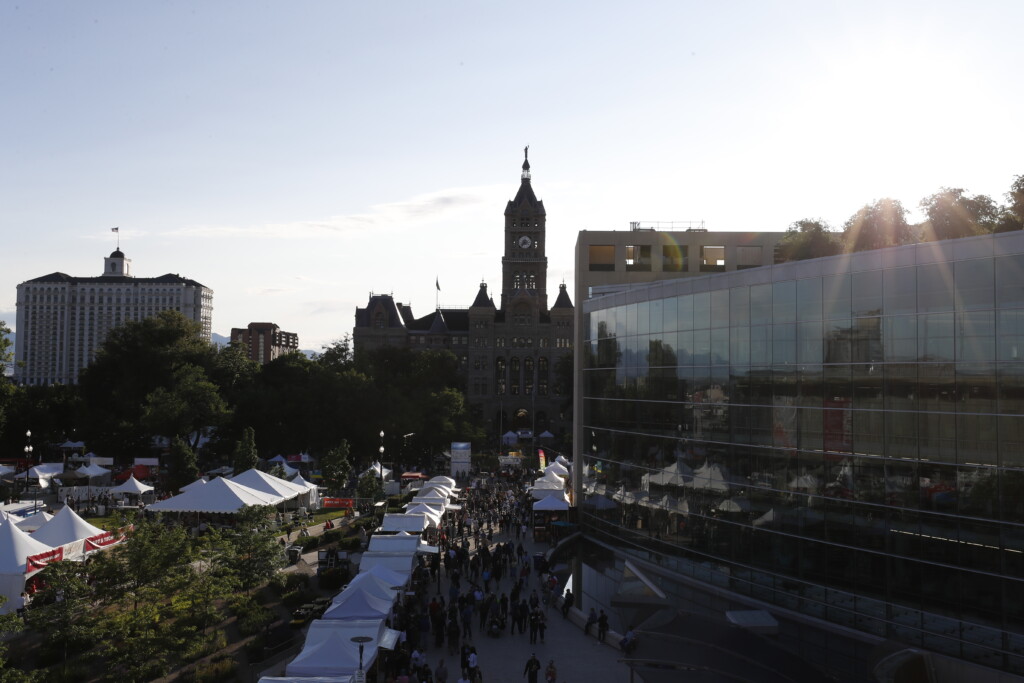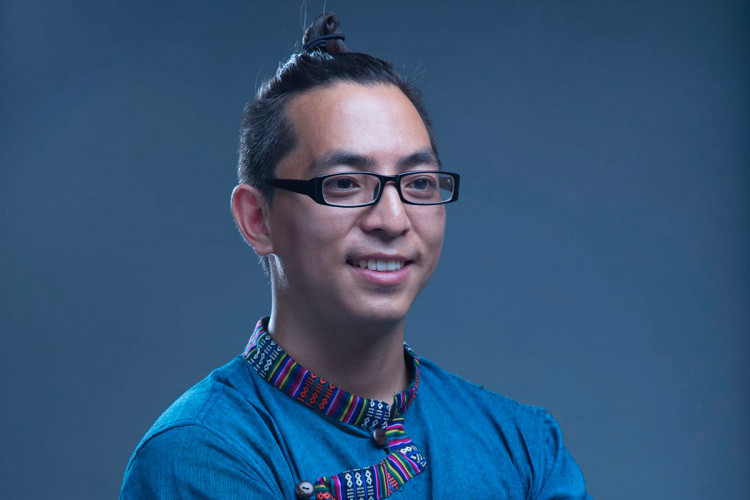EDITOR’S NOTE: The Utah Review begins its preview coverage today of the 45th Utah Arts Festival, which will be held Aug. 27-29 (noon to 11 p.m. on Aug. 27 and 28 and noon to 9 p.m. on Aug. 29) on the Library Square in downtown Salt Lake City. As this is the state’s largest multidisciplinary arts and cultural gathering each year, The Utah Review considers the Utah Arts Festival a worthy arts and cultural barometer for the state, as this curtain raiser indicates. For more information about this year’s festival, see the Utah Arts Festival website and ticket information here.
Returning after a pandemic hiatus
This summer, Utah’s arts organizations have emerged cautiously yet steadily after a shutdown of more than one year which started as the COVID-19 pandemic spread across the nation. The pandemic certainly tested the resilience of the arts and cultural institutions in the state, which prior to 2020 collectively have punched well above their weight class when it comes to arts participation. In statistics compiled before the pandemic, the Utah Cultural Alliance (UCA) reported that the arts industry in the state employs 155,551 people, generating $4.8 billion in earnings, $264.3 million in nonprofit revenue and $15.2 billion in gross sales. Utah represents the third fastest growing state in the country in numbers of jobs connected to the arts and cultural industry, at an annual rate of 4%.
The pandemic inflicted a sharp economic hit on the state’s arts and cultural industry, as noted in the UCA report, which estimated that $76.6 million was lost in terms of economic impact. But, the report also indicated encouraging numbers for Utah residents desiring to return to arts activities. The spring 2021 report showed that 53% of the respondents surveyed would be very open to attending a major outdoor event such as an arts festival within six months.
Thus, the Utah Arts Festival’s administrative decision to move this year’s event, normally held in June, to the last weekend in August was a prudent one. And, as the pace of vaccinations has regained most of its earlier momentum in the midst of a recent spike in cases, festival organizers will continue to follow effective protocols to reassure patrons that their experience is as safe and comfortable as possible. Festival organizers also have collaborated with the Salt Lake Regional Medical Center on producing short videos about enjoying the festival in healthful ways. This includes staying safe during the pandemic as well as the importance of using sunscreen and staying hydrated.
This year’s festival dates are not the annual calendar’s latest in UAF history dating to its founding in 1976. There were many years when the festival was held in September and the June dates became regular only when the new Library Square campus was completed in 2003. This year’s dates put the festival between two other late summer signature arts events: the just completed Craft Lake City and the Urban Arts Festival, which will be held on Labor Day weekend at The Gateway.
This year’s festival is shorter and smaller than in previous years but at least two program venues also will have among the largest offerings in their history at the event: the Literary Arts program, which is in its 26th year of live presentations, and Fear No Film, which is marking its 18th live presentation. The festival will use about 30 percent less space than in its most recent years.
There is one less stage (the Amphitheater Stage which normally has hosted evening headliners) but there also are more than 90 performing acts slated on the festival’s other stages, with many artists from the Utah scene making their first appearance at the event. More than 90 percent of the performers are from Utah this year, matching figures from the earliest years of the festival’s history.
Festival organizers also are using this year’s smaller scale festival to collaborate with groups on evaluating how accommodations can be improved for accessibility, which will be implemented next June when the festival returns to its normal calendar and schedule.
While the City Library has yet to allow outside events, indoor festival programs will be held at The Leonardo on the south side of Library Square, including the Fear No Film international short film programs. The Literary Arts program also features an extensive slate of BIPOC performers and literary figures who will be performing at The Leonardo’s Salt Cafe, as part of a partnership with the YWCA Utah. There also will be individual and team poetry and spoken word slams on the evenings of Aug. 27 and 28. Kase Johnstun, Literary Arts coordinator, also has scheduled performances by Artes de México en Utah, Torrey House Press, Color Collective, Poetry Out Loud winners and student readings from Salt Lake Community College, Weber State University, Brigham Young University and Utah Valley University.
The new BIPOC program is coordinated by Sarah May, the festival’s first community and inclusion coordinator.
There will be no Kids’ Art Yard but the festival has added a smaller scale Creative Zone that will augment the popular Arts and Technology venue. The Creative Zone (which will be open daily noon to 8:30 p.m.) features hand-on activities built on the theme of Songs of the World!, along with make-and-take projects sponsored by the Visual Art Institute, Utah Museum of Contemporary Art, Rock Canyon Poets and Utah Blues Society. The Art & Technology Zone, which operates like a DIY pop-up creative manufacturing site, will provide materials and assistance from Make Salt Lake members. Activities will include Lichtenberg wood-burning, 3-D printable zoo animal designs, programmable glockenspiels, mechanical flip books and planisphere to represent the constellations based on specific times and locations.
2021 Highlights
As a quick overview, while the Artist Marketplace is smaller this year (95 artists in order to accommodate 10-foot distancing between exhibition booths), nearly two-thirds of the artists come from outside Utah and 16 are making their first appearance at the festival. Some 623 artists applied for the 2020 festival but when it was postponed, accepted participants were given the option to roll over their booth fees, of which 60 artists took advantage. Those who were on the waitlist were then chosen to ensure a balanced representation in the media forms.
There are two new jazz commissions representing winners from 2020 and 2021, as well as the chamber music commissions. Dance commissions comprise five works, presented by Ballet West, in collaboration with artÉmotion and featuring live music by composer Michael Wall, Ballet West pianist Nicholas Maughan and artÉmotion Principal Faculty Jordan DeBona. Likewise, five dance companies will make festival appearances including Repertory Dance Theatre (which has appeared at every festival except for one year when the company was on tour in Europe), Ririe-Woodbury Dance Company, 1520 Arts, the Children’s Dance Theatre at The University of Utah, and Percussive Footwork Ensemble.
The 18th live presentation of Fear No Film includes 67 short films —ranging in length from four seconds to 27 minutes — as chosen from 22 countries besides the U.S. With the largest international representation ever in Fear No Film history, there also are short films from India, Croatia, Singapore and Iraq, countries being represented for the first time. While many of the films had premieres on streaming platforms, a good number will have their first live screening at Fear No Film. And, nearly 45% of the films have female directors, signifying the growth of representation in an industry that historically has been male dominated. The slate features narratives as well as documentary treatments, along with experimental and video art pieces and unique storytelling approaches in drama, comedy, horror and history. This year’s slate includes some of the strongest narrative treatments ever to be featured in Fear No Film. There also is the annual competition for Utah Made Short Film of the Year, in the student and professional categories. Audience members also will vote for their favorites in Fear No Film’s nine rotating programs.
The first festival day (Aug. 27) will feature soul music on the Park and Festival Stages with Moodlite, S2_Cool, Ryan Innes and Bri Ray appearing in the afternoon on the Park Stage and evening performances on the Festival Stage featuring The Will Baxter Band and The Nth Power. In the Urban Arts venue, female local artists will be painting the live mural on Aug. 28 and 29, highlighting their individual styles. Also, Mason Fetzer’s 100 Artists/1 Image installation returns to the festival’s Urban Arts venue for the 10th time.
Although the City Library is not hosting festival events, the building is open to visitors and this includes the exhibition Geoglyphs: Quilts by Roxanne Bartel, Sheryl Gillilan and Sondra Hodson-Rosier, which will be open from Aug. 21 through Oct. 1 in the Lower Urban Room. Inspired by a trip to petroglyphs near Moab, the artists decided to create quilted renditions of geoglyphs with the intention of expressing their own connections to the modern times of their existence.
The festival’s music commission program enters its fourth decade with world premieres of Resonant Machines by Theo Chandler, a Houston composer and clarinetist, and Bien by Chia-Yu Hsu, a Taiwan native who is associate professor of composition at University of Wisconsin at Eau Claire. Chandler, who has received numerous commissions and is pursuing his doctorate at Rice University, has set his piece as six short character studies representing various appliances, toys and vehicles. Chia-Yu’s work is inspired by the pandemic and rendered in a four-section single movement highlighting the trajectory of the pandemic from the initial onset and battles to contain the virus to elegy and grief and finally to the optimism of a post-pandemic world.
While the chamber music commissions were recorded earlier in the Libby Gardner Hall at The University of Utah for streaming online during the festival, the two jazz premieres will be performed at the festival on Aug. 27 at 6:30 p.m. Three-thirty on Thursday arises from the creative germ of a common blues music lick by Steve Erickson, a long-time performer with the U.S. Air Force Bands who is retired and works as a freelance musician, teacher and composer in the Salt Lake metropolitan area. The second commission comprises two works, Acclimation and Blues for Courtney by Tyler Chen, a professional drummer who graduated last year from The University of Utah’s jazz composition program and recently joined Samba Fogo, Salt Lake City’s award-winning Brazilian music and dance institution. In fact, Acclimation is based on his exploration of Brazilian music as well as his personal experiences during the pandemic. His second piece is a tribute to the late pianist Courtney Isaiah Smith.
This year’s Mayor’s Artist Awards, presented in conjunction with the Salt Lake City Arts Council (Aug. 27, 6 p.m., Festival Stage), include Lisa Sewell, the long-time executive director of the festival who stepped down last year after a 25-year tenure that established and expanded some of the festival’s most popular programs including Fear No Film and the Art & Technology venues. Other award winners include the Mestizo Institute of Culture and Arts (MICA), a grassroots cultural organization dedicated to arts, justice, belonging, and community power founded in 2003 by Ruby Chacón and Terry Hurst, and Framework Arts, a local nonprofit group targeted toward young artists with projects including Work, Love, The League of Reluctant Bicyclists, the Wisdom of the Water Closet, and Water, which is on display at the Utah Museum of Fine Arts as part of the Confluence show. Other recipients are Utah poet laureate Paisley Rekdal, who also will perform Aug. 28 at 6:30 p.m. at the Literary Stage and Dallas Graham, who established the Red Fred Project, which gives children with rare diseases and chronic illness the opportunity to create a book, of which more than a dozen have been published.
Development and Sponsorship
This also will be the first festival with Aimée Dunsmore as the new executive director. Succeeding Dunsmore in her former role as UAF development director is Meagan Mod, who moved to Utah earlier this year from Louisiana.
Some 65 percent of the organization’s annual revenue comes from the festival but Dunsmore also is looking to build a stronger year-round visibility for UAF’s presence and opportunities to create new engagements in its development efforts. This coincides with UAF efforts on diversity, equity and inclusion programming and ways to highlight the programming of its various venues. The Holiday Art Show during the end-of-the-year holiday season has become a popular fixture but the festival organizers also recently decided to move its popular Mardi Gras masquerade party from the winter to October, closer to Halloween. The masquerade party is one of the most successful non-festival events for UAF.
Corporate sponsors are critical but the festival staff also has continued to expand its efforts in tapping creatively into the individual donor’s psyche, particularly in shepherding fundraising efforts that point toward a legacy relationship potentially stretching across several generations. Among corporate sponsors making a first-time presence at the festival are the University Credit Union and the BON V!V hard seltzer company, which has targeted the SLC market, including the launch of one of its newest flavors, raspberry dragonfruit. As SLCLunches writer Heather King reported, Salt Lake was handpicked as a launch market based on 2021 sales of their hard seltzers which have tripled other U.S. markets. There will be plenty of food and beverage offerings, including 15 food business vendors along with the Uinta Brewing Company Lounge, located just east of the Garden Stage.
Meanwhile, membership numbers of the Friends With Benefits program, now in its 12th year, grow steadily, despite slowing during the pandemic hiatus. The program is a vital springboard for the festival’s development program, which seeks to expand the individual donor base along with its ongoing corporate sponsorship program.
Some 65 percent of the organization’s annual revenue comes from the festival. One of the festival’s best fundraising events, which always sells completely, is the Big Deal Brunch, held on the closing day, prior to the gates being opened. This will be the seventh time for the brunch.
Mod is planning to expand upon the theme that UAF has established in customizing fundraising approaches to connect with different audiences and markets for the festival. One of the most successful approaches resonates with the same casual, close-knit family or community ambience that drives the festival’s overall vibe. Hospitality is key, according to Mod, who sees valuable returns in keeping the approach soft and low key without putting too much pressure. In the Friends with Benefits program, donors can start modestly at $50 annually or select one of multiple contribution levels ranging in manageable increments to $2,000 or more. Many members consider it a bargain because the rewards in return easily are three, four, or more times the donated investment, Mod explains. Dunsmore adds that when the festival was postponed last year which meant that the customary benefits of tickets and hospitality passes would not be available along with other amenities based on giving levels, 98 percent of Friends nevertheless opted to make their same donation available to UAF. This was an important distinction because donations are fully tax-deductible provided no goods or services are received by the donor. Opting into receiving benefits lowers the donation’s tax-deductible value. “We deeply appreciated just how much the Friends supported the festival during the difficult stretch of the pandemic,” Dunsmore adds. There also are options for interested donors to make planned or stock gifts and patrons can list the UAF as their nonprofit of choice on rewards program cards including Smith’s Shopper Card or their Amazon Smile account.
The sly whimsical approach has worked especially well for Friends Who Give A Crap, which is being offered for the fifth time. Every available Port-A-Potty was claimed in 2019 by donations. For $75, a donor can sponsor a Port-A-Potty, and in return, will have their names featured on a unit along with a pair of festival tickets and a miniature commemorative foam potty. In 2018, one donation was marked by a marriage proposal. Dunsmore says the campaign resonates well with prospects who otherwise might not donate if the approach seemed too formal or even snobbish. Indeed, restrooms are an unexpected appeal. Dunsmore says that more than a few Friends with Benefits members cite the access to the excellent mobile restroom facilities on the Hospitality and Sponsor Patio as a highly desired perk of membership.
Volunteers also represent a potent festival advantage, especially in ensuring that each year’s programming always incorporates new elements in various ways. Each year, hundreds sign up to volunteer for what essentially is a miniature city of arts and culture. The average value of that volunteer effort is a critical element in grant or foundation proposals – with a calculated value of $25 per volunteer hour. Meanwhile, the cost of staging the festival per person has increased dramatically within this decade – by as much as 60 percent to between $25 and $30 per person.
Tickets and Admission
This also will be the 23rd year in offering admission for free to children, 12 and under, thanks to the allocation of sales tax revenue earmarked for Salt Lake County’s Zoo, Arts and Parks (ZAP) program. Some 60 percent of festival goers have taken advantage of various ticket discounts and thousands of tickets are given free to underserved and special needs populations.
Tickets at the gate will remain the same price as in 2018 and 2019 at $15 each. For tickets purchased in advance, there is a $2 discount. Seniors and those with military IDs can purchase tickets for $8 at the festival box office. Bicyclists also will receive a $2 discount. UAF organizers also will monitor traffic flow into the festival in the event of assuring patron safety and social distancing.
This also will be the first year where UAF is making tickets purchased online to be sent straight to a patron’s email inbox or mobile device via QR codes. Online tickets can be purchased through the end of the festival, so individuals can purchase before they arrive, en route, or even from a mobile device upon arrival at festival grounds. In-person purchases at the festival box office, however, will continue to be by cash only.
Note
Follow The Utah Review daily through Aug. 26 for in-depth previews and interviews of various venue performers and activities. And, follow The Utah Review’s Instagram and Twitter accounts and feeds throughout the festival’s three days, which will be coordinated by Huber Alday, social media editor.











1 thought on “Utah Arts Festival 2021: Slimmer, shorter but still state’s most comprehensive arts and cultural celebration of the year”